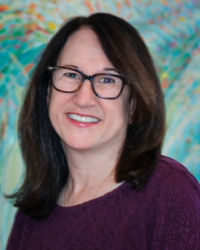Candidate Bio

Leslie Beth Eber, MD, CMD, is board-certified in internal medicine and is a Certified Medical Director. She has provided medical directorships for long-term care facilities and hospice and is the medical director for multiple facilities as a part of Rocky Mountain Senior Care, in Denver Colorado. She serves as the Chief Faculty for Abode Care Partners. Dr. Eber has served on the national board of AMDA - The Society for Post-Acute and Long-Term Care Medicine since 2019, as both State President Council Representative and currently as Secretary. She is a clinical advisor for the AMDA Moving Needles CDC grant: Improving Adult Immunization Rates for COVID-19, Influenza, and Routine Adult Vaccinations through Partnerships with the Long-Term Care Professional Society. In 2021, Dr. Eber received the AMDA Medical Director of the Year award. She has provided expertise for several national initiatives including the Colorado AHRQ ECHO National Nursing Home COVID-19 Action Network and presented for the ECHO COVID-19 Global Conversations: Vaccine Development, Distribution and Delivery. Dr. Eber has represented AMDA as an AMA Delegation since 2021. Through her dedicated work with the Colorado Dementia Partnership, Dr. Eber has developed many tools to help care for patients struggling with dementia. Dr. Eber had the honor to serve as president of CMDA – The Colorado Society for Post-Acute and Long-Term Care Medicine from 2016 - 2021. She continues her work on the CMDA executive board as immediate past president.
Candidate Statement
I am honored to be a candidate for Vice President of AMDA.
Being a part of the AMDA community has truly been a highlight in my career. Our community is known for its unique combination of expertise and empathy. It is how we treat our patients and how we show up for one another that makes AMDA a distinct and essential voice. I have the privilege to run beside my friend, Vickie Walker—AMDA is richer for her wisdom and leadership.
Looking at AMDA today, we can pose 3 questions. Where are we now? Where are we going? How do we get there? Our AMDA leadership has consistently been thoughtful, creative, and intellectually inspiring. As we stand on the shoulders of those who built AMDA into what it is today, we can see further and with greater depth.
Where are we now? Building on years of expertise, our AMDA view has improved. We now have a national seat at the table. We collaborate with the CDC through our Moving Needles grant, utilize our progressive workforce development committee, and continue to work on diversifying our own collective voice as experts in PALTC. We successfully transitioned to a new, innovative executive director and continue partnering with our remarkable AMDA staff. After years of advocacy, we will now have a National Medical Director Registry thanks to the work of so many! We share our educational expertise on multiple platforms, including podcasts and grand rounds.
Where are we going? The post-pandemic realities of PALTC require AMDA to be deliberate and focus our efforts on increasing access to quality care, making our professions more sustainable, and elevating our impact through strategic partnerships. To achieve this, we can focus on 3 primary issues: communication, membership, and state chapter engagement.
How can we get there? First, our communication strategy both within AMDA and outwardly will be a key determinant of our success. Looking inward, are we listening to you, our members? Are we effectively addressing your priorities and communicating our pathway forward? Outwardly, are we effectively sharing our expertise in ways that resonate with our audience? Are we getting asked on a second date?
Internally, AMDA’s new website will streamline access to the tools and resources our society has meticulously created. The updated website will also allow us to communicate our current initiatives and highlight our advocacy efforts and our new PALTC benefits program. Externally, we communicate through thoughtful policy initiatives and national partnerships. We will continue our efforts regarding transparency, advocating for the growth of our workforce, and improving patient access to care. By promoting these priorities at the national level, AMDA’s expertise will expand and deepen our impact.
My second goal prioritizes membership. Like other medical societies, our membership is shrinking. Addressing this requires both listening to and actively translating your priorities. What made you want to join this community? What would make your colleagues want to attend our annual conference? What makes AMDA compelling? I want to explore ways that AMDA can be the glue throughout your career.
Finally, I will prioritize strengthening our state chapters and better aligning them with our national society. I had the honor of serving as president of our Colorado state chapter for 5 years, and I continue my work on our executive board under the phenomenal leadership of Dr. Sing Palat. With experience on multiple sides of this relationship, I hope to further facilitate states sharing their local expertise. Sharing our secret sauce should be easy. Harnessing the talent within our state chapters will be a key strategy to grow our society and increase AMDA’s footprint.
Communication and collaboration are the cornerstones of my leadership style. I aim to identify and amplify the priorities of our community. Through collaboration and mutually beneficial partnerships, I hope to open more doors for AMDA and our members.
I have had the honor of serving on the AMDA board for the past 5 years, first as State Presidents Council Representative and currently as Secretary. My work on vaccine hesitancy, the Moving Needles CDC grant, COVID-19 education, and representing AMDA as an AMA delegate has given me a broad view of AMDA’s reach and its potential. I believe in leadership that harnesses the knowledge, perspective, and innovation we cultivate within AMDA.
Looking at where we are now and the possibilities that lie ahead, I could not be more excited about the future of AMDA. I would be honored to serve the AMDA community as Vice President during this critical time.

